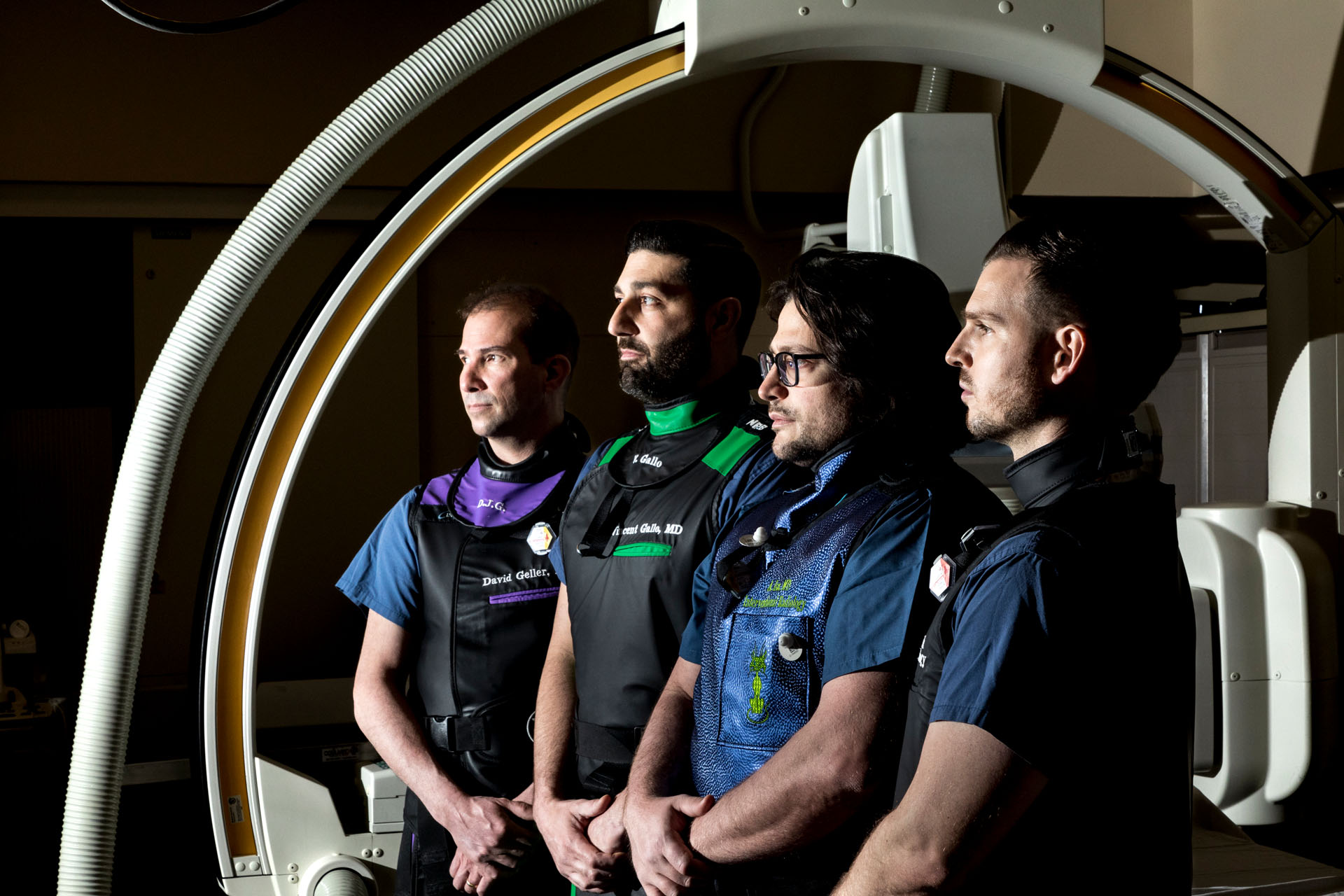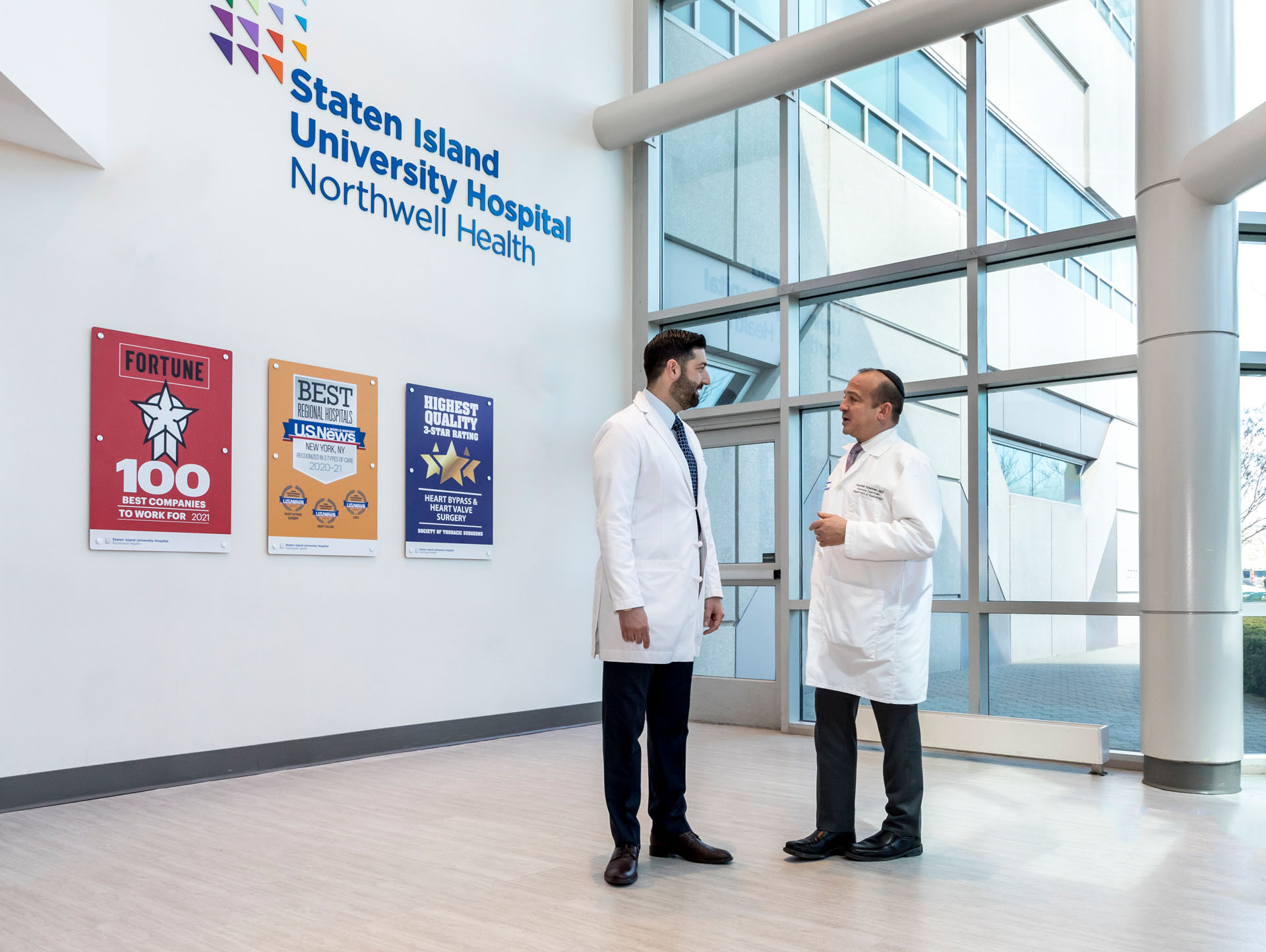THROUGH GROUNDBREAKING, MINIMALLY INVASIVE PROCEDURES AND A CULTURE OF CONTINUITY, SIUH’S DEPARTMENT OF INTERVENTIONAL RADIOLOGY IS DEDICATED TO CHANGING THE FACE OF MEDICINE
BY AMANDA McCOY • PHOTOS BY AMESSE PHOTOGRAPHY
According to the Centers for Disease Control and Prevention, every year 35,000 Americans are diagnosed with liver cancer. But beyond the traditional therapies used to treat patients with cancer of the liver such as transplant, resection, radiation, and chemotherapy recent advances in interventional radiology now offer alternatives: hyper-targeted, outpatient procedures without systemic side effects like hair loss, nausea, and heart damage. In liver-directed therapy, for example, interventional radiologists place catheters into the arteries that supply blood to tumors of the liver, and under image guidance, they inject micro particles that deliver chemotherapy or radiation directly to the tumor while also cutting off its blood supply. To provide borough residents with groundbreaking treatments such as these, Staten Island University Hospital is investing $45 million into the new Florina Cancer Center, and interventional radiology will continue to play a more prominent role in the future of cancer treatment.

“Many people in Staten Island aren’t aware of the comprehensive cancer care they can receive here,” noted Vincent Gallo, MD, director of Vascular and Interventional Radiology at SIUH. “It doesn’t end with chemotherapy; there’s a full spectrum of minimally invasive procedures available.”
This is only one of many areas where interventional radiology is changing the face of modern medicine through minimally invasive therapies that are, in many cases, even less invasive and more efficacious than open procedures. Often described as the surgery of the new millennium, interventional radiology uses image-guidance to diagnose and treat conditions in nearly every organ system of the body
“We work very closely with almost every specialty within medicine,” said Dr. Gallo, who joined SIUH in August 2020. Triple board certified in internal medicine, diagnostic, and interventional radiology, Dr. Gallo obtained a fellowship in Vascular and Interventional Radiology at SUNY Downstate after completing his residency in Internal Medicine and Diagnostic Radiology. Prior to joining SIUH, he spent several years at a private practice in New Jersey, where he honed his abilities in complex, cutting-edge minimally invasive procedures, a specialized skill set he now brings to the borough.

“I wanted to go somewhere I could establish my footprint,” said the doctor of his relocation to Staten Island. “At SIUH, I could integrate all three aspects of my background internal medicine, diagnostic, and interventional radiology into the department while also having the ability to teach residents and fellows.”
Dr. Gallo’s first order of business as department lead was to create relationships and establish a baseline of trust with every tech, nurse, and doctor. Once trust was established, he created an interventional radiology outpatient office, where patients receive a full consultation prior to the intervention, and practitioners follow up with them after the procedure. According to Dr. Gallo, this was a culture changer, as it allowed the department to have a sense of ownership of their patients’ care.
“We see patients in our office first,” explained the doctor. “We meet with them to discuss the procedure, the risks, benefits, alternatives, and answer any questions they have. Most procedures are then scheduled and performed as an outpatient. The patient is then scheduled to follow up in the interventional radiology office afterward. This sounds obvious, but for 25 years, this didn’t happen in the field of interventional radiology.”

Radiology is generally divided into two areas: diagnostic and interventional. Diagnostic radiology helps physicians see structures within the body, while interventional radiology uses imaging modalities such as CT, ultrasound, MRI, and fluoroscopy to guide minimally invasive procedures. “These interventions are typically outpatient procedures,” said Dr. Gallo. “They are performed through a pinhole puncture that only requires a band-aid and rarely any stitches. Patients commonly go home after a couple of hours.”
Through advanced imaging technology, interventional radiologists are able to address a wide range of ailments that once required open surgery. For Americans with osteoarthritis, there’s a new procedure currently being evaluated in clinical trials that offers a minimally invasive alternative to knee replacement. To treat women’s conditions like uterine fibroids (noncancerous growths of the uterus), a hysterectomy is traditionally the most common approach, but a leading-edge procedure called uterine artery embolization offers a far less invasive alternative that leaves the patient with only a tiny aperture on her wrist.
“We go through a pinhole puncture in the artery of the left wrist, and under X-ray guidance we insert a spaghetti-sized micro catheter into the blood vessel,” explained Dr. Gallo of the procedure. “Contrast dye is then injected to confirm appropriate positioning of the catheter within the uterine artery. Once felt to be in a safe position, micro particles are injected, reducing blood flow to the fibroids while sparing most normal uterine tissue. The procedure takes approximately 45 minutes to an hour, and when we’re done, the catheter comes out and the patient leaves with a band-aid on her wrist. There is no scar, no stitches, no hospitalization, less chance of infection or post-op complications, and the patient maintains the ability to become pregnant.”
Another recent ground-breaking advancement for patients with end-stage kidney disease is called percutaneous endovascular arteriovenous fistula (AVF) creation, a procedure that has just been adopted recently. In order for patients to undergo hemodialysis, an arteriovenous fistula (a connection between the artery and vein) needs to be created within the upper extremity to serve as a vascular access point during hemodialysis. Traditionally, the fistula was created surgically, and typically takes 90 days to become “mature” enough to be used. Now, through minimally invasive percutaneous intervention, the AV fistula can be created through a pinhole puncture, with a much shorter turnaround time of 45-60 days.
“The AV access may require additional minimally invasive outpatient maintenance to ensure it is functioning properly,” said Dr. Gallo. “The goal is to provide the patient with a dependable AV fistula that does not disrupt their hemodialysis schedule.”

Offering these advancements on Staten Island holds special meaning for Dr. Gallo, who noted that there isn’t a procedure in interventional radiology that his department cannot perform. Enrolling in clinical trials and investing in clinical research remains a top priority for the doctor as part of an ongoing e ort to ensure Staten Island residents have access to the latest technologies to treat their diseases.
“We want to take care of our own neighborhood; Staten Island residents can expect the same high-level of care here that they could find at any other institution,” said Dr. Gallo. “It is no longer necessary to commute to other sites within the tri-state area when they can undergo these complex procedures minutes from their own homes.”
Looking ahead, Dr. Gallo noted he plans to continue expanding upon the department’s services and fostering relationships with every subspecialty across the Northwell network.
“The future of interventional radiology is exciting,” said Dr. Gallo. “We can perform these highly effective minimally invasive procedures that used to require multiple days to recover. Most are now outpatient procedures, and the patient leaves within hours after its conclusion. Staten Islanders have so many more options available to them now. At SIUH, we will continue to expand our services, continue to enroll in clinical trials and provide our patients with the most cutting-edge, up-to-date technologies. For me, being able to see an almost-immediate improvement in patients’ health and quality of life is the most rewarding aspect of this profession.”

SIUH Department of Vascular and Interventional Radiology
475 Seaview Avenue / 718.226.9181
siuh.northwell.edu/vascular-interventional-radiology
